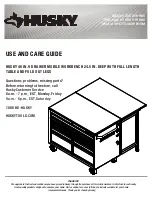
HYPERMAX OS
HYPERMAX OS offloads data into a Storage Resource Pool. One or more Storage
Resource Pools are pre-configured before installation and used by a variety of
functions. DSE can use a Storage Resource Pool pre-configured specifically for DSE,
or if no such pool exists, DSE can use the default Storage Resource Pool. All SRDF
groups on the array use the same Storage Resource Pool for DSE. DSE requests
allocations from the Storage Resource Pool only when DSE is activated.
The Storage Resource Pool used by DSE is sized based on your SRDF/A cache
requirements. DSE is automatically enabled.
Enginuity 5876
Enginuity 5876 offloads data to a DSE pool that you configure. You must configure a
separate DSE pool for each device emulation type (FBA, IBM i, CKD3380 or
CKD3390).
l
In order to use DSE, each SRDF group must be explicitly associated with a DSE
pool.
l
By default, DSE is disabled.
l
When TimeFinder/Snap sessions are used to replicate either R1 or R2 devices, you
must create two separate preconfigured storage pools: DSE and Snap pools.
Mixed configurations: HYPERMAX OS and Enginuity 5876
If the array on one side of an SRDF device pair is running HYPERMAX OS and the
other side is running a Enginuity 5876 or earlier, the SRDF/A session runs in Legacy
mode.
l
DSE is disabled by default on both arrays.
l
EMC recommends that you enable DSE on both sides.
Transmit Idle
During short-term network interruptions, the transmit idle state describes that
SRDF/A is still tracking changes but is unable to transmit data to the remote side.
Write folding
Write folding improves the efficiency of your SRDF links.
When multiple updates to the same location arrive in the same delta set, the SRDF
emulations send the only most current data across the SRDF links.
Write folding decreases network bandwidth consumption and the number of I/Os
processed by the SRDF emulations.
Write pacing
SRDF/A write pacing reduces the likelihood that an active SRDF/A session drops due
to cache exhaustion. Write pacing dynamically paces the host I/O rate so it does not
exceed the SRDF/A session's service rate, preventing cache overflow on both the R1
and R2 sides.
Use write pacing to maintain SRDF/A replication with reduced resources when
replication is more important for the application than minimizing write response time.
Remote replication solutions
SRDF/A cache management
133
Содержание VMAX 100K
Страница 1: ...EMC VMAX3 Family Product Guide VMAX 100K VMAX 200K VMAX 400K with HYPERMAX OS REVISION 6 5 ...
Страница 20: ...Preface 20 Product Guide VMAX 100K VMAX 200K VMAX 400K with HYPERMAX OS ...
Страница 46: ...VMAX3 with HYPERMAX OS 46 Product Guide VMAX 100K VMAX 200K VMAX 400K with HYPERMAX OS ...
Страница 72: ...Open systems features 72 Product Guide VMAX 100K VMAX 200K VMAX 400K with HYPERMAX OS ...
Страница 82: ...Provisioning 82 Product Guide VMAX 100K VMAX 200K VMAX 400K with HYPERMAX OS ...
Страница 100: ...Native local replication with TimeFinder 100 Product Guide VMAX 100K VMAX 200K VMAX 400K with HYPERMAX OS ...
Страница 158: ...Remote replication solutions 158 Product Guide VMAX 100K VMAX 200K VMAX 400K with HYPERMAX OS ...
Страница 186: ...Mainframe Error Reporting 186 Product Guide VMAX 100K VMAX 200K VMAX 400K with HYPERMAX OS ...
Страница 200: ...Licensing 200 Product Guide VMAX 100K VMAX 200K VMAX 400K with HYPERMAX OS ...
















































